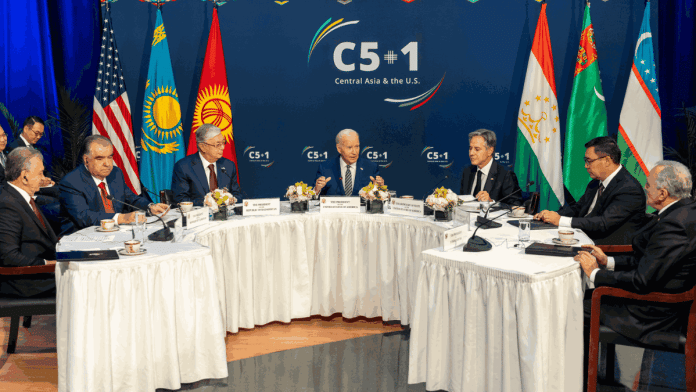New Delhi: US President Joe Biden Tuesday met with the leaders of the five Central Asian republics in New York City on the sidelines of the United Nations General Assembly (UNGA), in an effort to strengthen America’s role in a region with historical ties to Russia and bordering China.
The first Central Asia 5+1 summit (C5+1) organised by the Biden administration included the President of Kazakhstan, Kassym-Jomart Tokayev, the President of Uzbekistan, Shavkat Mirziyoyev, the President of the Kyrgyz Republic, Sadyr Japarov, the President of Tajikistan, Emomali Rahmon, and the President of Turkmenistan, Serdar Berdimuhamedow.
At the inaugural summit, Biden discussed the development of the Trans-Caspian Trade Route (the Middle Corridor) by proposing to launch a C5+1 critical minerals dialogue. The Central Asian republics are rich in mineral wealth — Kazakhstan in oil, Turkmenistan in gas, Uzbekistan in gold and precious metals, Tajikistan in rare earth elements and the Kyrgyz Republic in precious metals — and are geographically surrounded by Russia, China, Iran and Afghanistan, countries not on friendly terms with the US.
The Middle Corridor connects Asia and Europe via Kazakhstan and the Caspian Sea. Goods enter the Caucasus through the port of Baku in Azerbaijan and continue to Georgia from where two alternative routes to Europe exist — the European Union (EU) via Bulgaria or Romania through a land-based route via Türkiye or a maritime route through the Black Sea.
Biden also promised to drive US investment to the Middle Corridor and support its development through the G7’s Partnership for Global Infrastructure and Investment (PGII). This comes amid the US’ push to offer an alternative to China’s Belt and Road Initiative (BRI) through the development of economic corridors.
“The leaders discussed a range of issues including security, trade and investment, regional connectivity, the need to respect sovereignty and territorial integrity of all nations, and ongoing reforms to improve governance and the rule of law,” a White House readout on the meeting said.
Biden called the C5+1 summit a “historic moment” building on years of “close cooperation” between the US and the Central Asian republics — “a cooperation that is grounded in our shared commitment to sovereignty, independence, [and] territorial integrity”.
The six leaders agreed to strengthen counterterrorism cooperation — including an increase in funding from the US on the same — regional economic connectivity and a new initiative in disability rights, Biden said after the summit.
The US committed its support to the India Middle East Europe Economic Corridor (IMEC) and the Lobito Corridor in sub-Saharan Africa during the G20 summit in New Delhi earlier this month.
In its effort to offer an alternative to China across all continents, the US now joins a long list of global suitors jockeying for influence in Central Asia, including the European Union (EU), Russia and China.
Also read: 2 visits in single term? President Biden invited by Modi as chief guest for Republic Day celebration
Central Asia’s strategic potential
Central Asia is strategically located, and has historically been seen as a “land bridge” between Europe and Asia.
A study funded by the European Commission and published in June 2023 acknowledged the strategic potential of the region. It underscored the importance of alternative supply routes due to the Covid-19 pandemic and Russia’s invasion of Ukraine — highlighting the Middle Corridor as a viable alternative to existing supply routes.
The US Department of State Integrated Country Strategy (ICS) for Kazakhstan published in May 2022 called the country an “important partner” for the US, given its geopolitical location at the “crossroads of Eurasia”. The ICS acknowledged Russia and China’s significant ties with the country — saying the US’ “ongoing Enhanced Strategic Partnership with Kazakhstan offers the country desirable alternatives”.
Within 2023, the Central Asian republics have held high-level meetings with Russia, the European Union, the US as well as China.
President Xi Jinping held a China + Central Asia 5 (C+C5) Summit in May 2023 in the city of Xi’an, in an attempt to strengthen its influence there. The same month, all five leaders of the Central Asian republics joined President Vladimir Putin in Moscow for Russia’s 9 May Victory Day parade.
In June 2023, the President of the European Council, Charles Michel, met four Central Asia leaders and a representative from Turkmenistan in Cholpon-Ata, Kyrgyz Republic. The high-level meeting reviewed “multilateral and mutually beneficial cooperation” and discussed “the EU–Central Asia relations”, according to a joint communique.
(Edited by Smriti Sinha)
Also read: Religion key to national identity in Sri Lanka & Southeast Asia, finds Pew Survey






